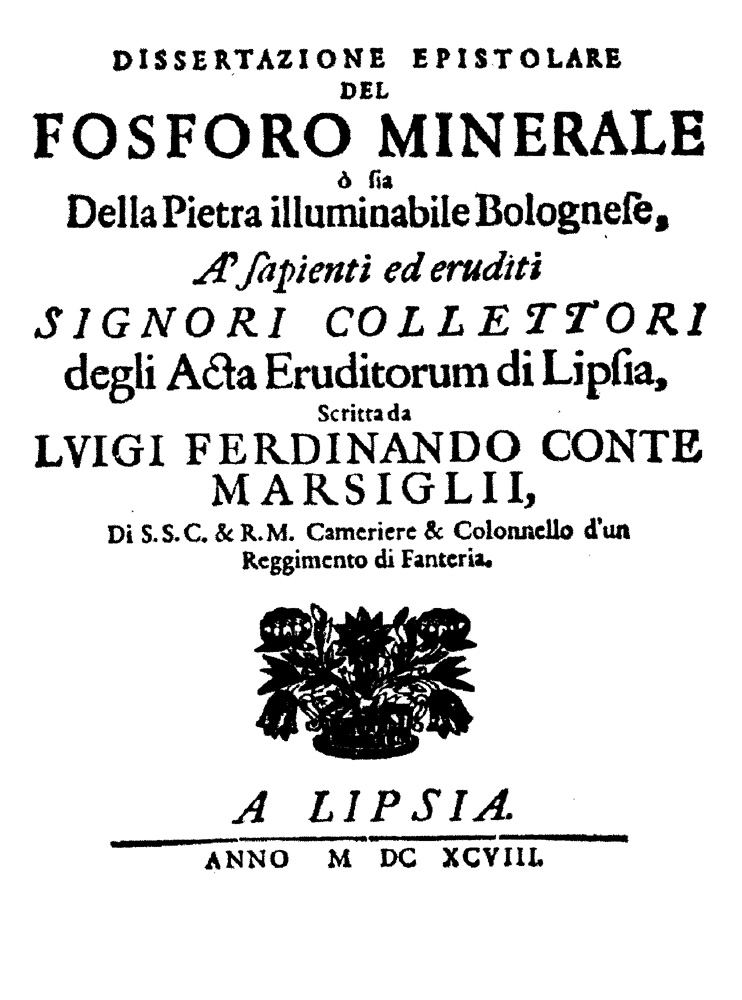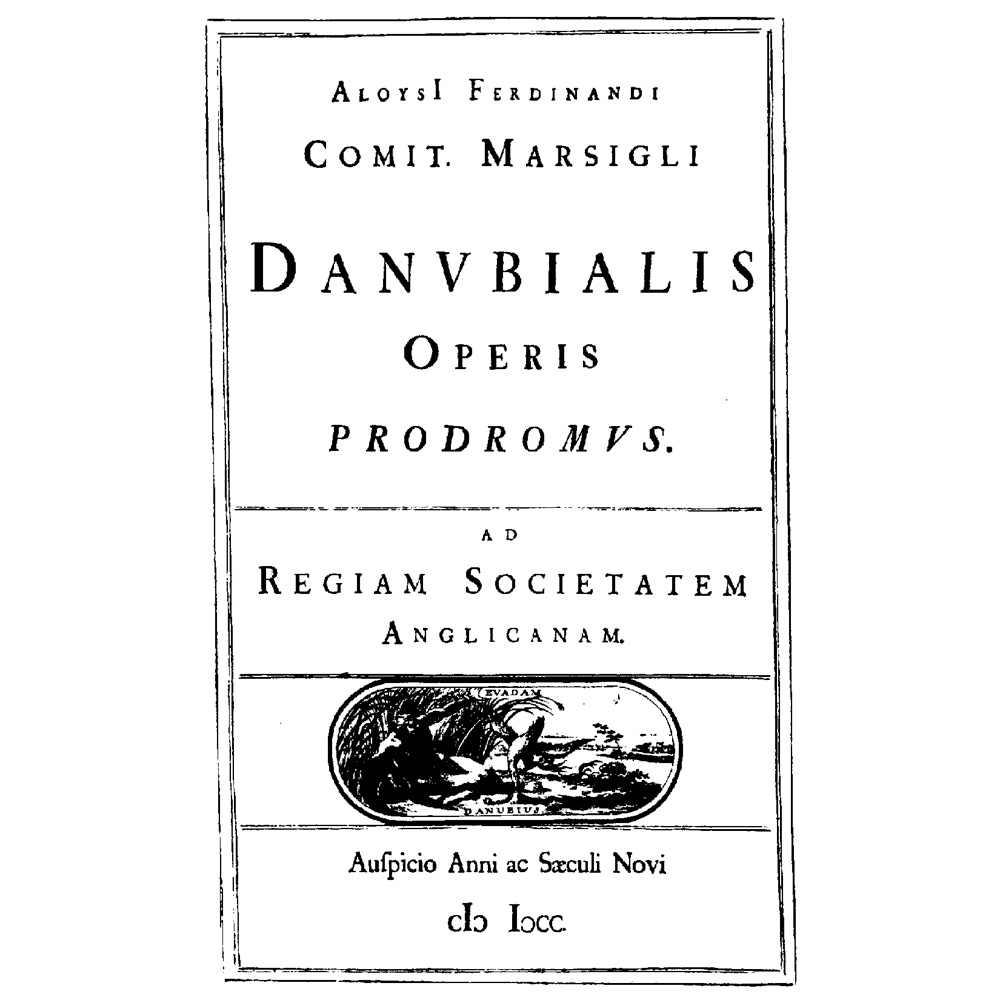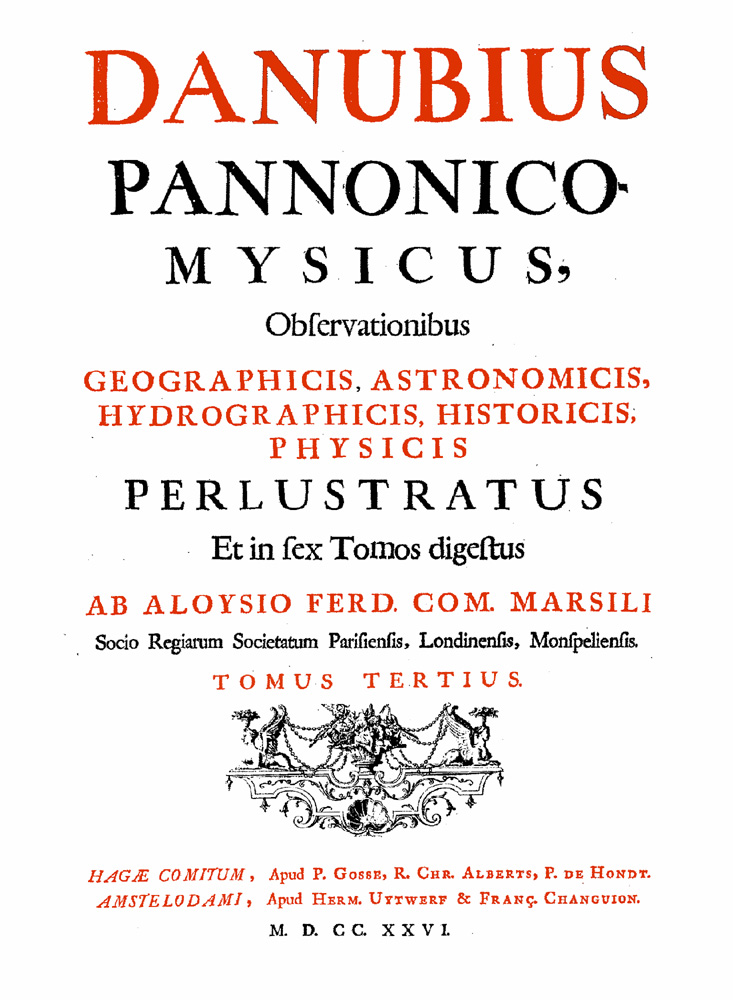MARSIGLI, Luigi Ferdinando, Conte.
(1658 – 1730)
Marsigli was born to a noble family of Bologna. He did not complete his formal schooling, but he accumulated a vast knowledge of history, politics, geography, and the natural sciences. He undertook the exploration of two basic subjects: the structure of mountains and the natural condition of the sea, lakes, and rivers. He left many local observations concerning the structure of mountains. In 1724 he published the first treatise on oceanography, Histoire physique de la mer. In it he examined every aspect of the subject, including the physical (or geological) formation of basins and the plants and fish that lived in the sea. He founded the Accademia delle scienze dell'Istituto di Bologna in 1712. He served in the army of Emperor Leopold I, partly as an engineer, from 1682 to 1704, and attained high rank. He was used by the Emperor on diplomatic missions to the Pope and in peace negotiations with the Turks. This employment ended in dishonor when Marsili was involved in the surrender of Breisach. In 1708, when imperial troops threatened the Papal States during the War of the Spanish Succession, Marsili headed the Papal army. And later, about 1715, he inspected the defenses of the Papal States against possible Turkish raids on the Adriatic coast. He spent considerable time during his retirement along the French coast near Marseilles. Much of his study of the sea stems from these stays.
Marsili participated in the Accademia degli Inquieti in Bologna. In 1702 he built an observatory in his palace. He collected a museum. In 1712 he founded the Academia delle Scienze dell'Istituto di Bologna, which under his influence, immediately became an active center of scientific research, consisting mainly of natural history exploration of the area around Bologna. The Institute absorbed in Accademia degli Inquieti. In founding the Institute, Marsili gave it his collection and gave his house to the city for the Institute. In 1715, a member of the Académie Royale des Sciences, replacing Viviani. He was a member also of the Académie Royale des Sciences of Montpellier. He went to London in 1722 to be made a member of the Royal Society. Newton insisted on presenting him personally and praised him as both an already famous scientist and a founder of the new Academy of Bologna. He produced a mineralogical map of the Danube basin, showing mining sites with some geology.
Biographical references: ABI: I 621, 215-263; 621, 313-338; II 363, 20-31; II S 52, 71-72. • Benvenuti, Dizionario degli Italiani all'Estero, 1890. • Csíky, Forerunners of Mining-Geology Mapping, 1984. • De Tipaldo, Biografia degli Italiani, 1834-45. • Ducati, P., Biographie Luigi Ferdinando Marsili. Milano, 1931. • Fantuzzi, G., Memorie della vita del generale conte L.F. Marsili. Bologna, 1770. • Frantuzzi, G., Notizie degli scrittori Bolognese. Bologna, 1780-9: 5 (1781), 286-327. • Frati, L., Catalogo dei Mss di Marsili. Firenze, 1928. • Imperatori, Dizionario di Italiani all'Estero, 1956. • Longhena, M. and A. Forti, "L.F. Marsigli e le sue osservazioni sul lago di Garda.", Atti Accad. Agrio. Sci. Lett., Verona. Series 5., 9, 35 p., 12 figs. • Longhena, M., Il conte L.F. Marsili. Milan, 1930. • Neviani, A., "", Atti Pont. Accad. Sci. Nuovi Lincei, 84, (1931), 376-483 & 85, (1932), 49-72. • Neviani, A., "La precisa data di nascita del conte L.F. Marsili", Rivista Stor. Scienze med. nat., 34, (1934). • Nissen (ZBI): 116 [other refs.]. • Parenti, Aggiunte al Dizionario, 1952-60. • Saccardo, P.A., "La botanica in Italia", Memorie del Istituto Veneto di Scienze, Lettere ed Arti, 26, (1895), 104, & 27, (1901), 67-8. • Sarjeant, Geologists, 1980: 3, 1659-60. • Stoye, J., Marsigli's Europe, 1680-1730: The Life and Times of Luiigi Ferdinando Marsigli, Soldier and Virtuoso. Yale University, 1994. xii, 356 p., illus. [ISBN 0300055420]. • WBI.

1. Latin, 1698 [First edition].
Dissertazione Epistolare | Del | Fosforo Minerale | ò sia | Della Pietra illuminabile Bolognese, | A' sapienti ed eruditi | Signori Collettori | degli Acta Eruditorum di Lipsia, | Scritta da | Lvigi Ferdinando Conte | Marsiglii, | Di S.S.C. & R.M. Cameriere & Colonnello d'un | Reggimento di Fanteria. | [ornament] | A Lipsia. | [rule] | Anno M DC XCVIII.
4°: A-D4; 16l.; [1]-31, [1] p., 19 plates (some folding). Title vignette.
Rare. The second paper in Italian describing the famous Bolognian stone (phosphorescent barite) was Marsigli's Del Fosforo Minerale that contained illustrations of the subject. Originally Marsigli had intended to publish the booklet as a present for Robert Boyle but had set it aside in 1691 after Boyle's death. The text was abstracted in the Philosophical Transactions of 1698 (see: 20, 306). The author was dissatisfied with the current explanation of the light emission and thinks the stone is reflecting more light than it is transmitting. He also preformed chemical analysis of the stone which he regarded as a type of talc and found that it contained sulfur and what he thought was mercury.
Bibliographical references: BL [B.396.(6.)]. • Gatterer, Mineralogischen Literatur, 1798-9: 2, 13. • Harvey, History of Luminescence, 1957: p. 315 [reproduces the title page]. • Hoover Collection: no. 562. • LKG: XVI 114. • Philosophical Transactions of the Royal Society of London: 20 (16??), 308 [review].
2. Italian, 1702 [2nd edition].
Dissertazione Epistolare del Fosforo Minerale ò sia Della Pietra illuminabile Bolognese, ... Editio auctior; Latine et Italice juxta exemplar Lipsiens. impress. 1702.
4°: 62 p., one plate. Very rare.
Bibliographical references: BL [no copy listed]. • Gatterer, Mineralogischen Literatur, 1798-9: 2, 13.

3. Latin, 1700 [First edition].
[Contained within a double rule box:] AloysI Ferdinandi | Comit. Marsigli | Danvbialis | Operis | Prodromvs. | [rule] | Ad | Regiam Societatem | Anglicanam. | [rule] | [vignette] | Auspicio Anni ac Sæculi Novi | cI[Backwards C] I[Backwards C]cc.
2°:
Very rare. Marsigli's most ambitous of literary projects was proposed in 1700 in the Danudialis Operis Prodromus. Copies began to circulate in 1701, when readers everywhere could see for themselves what Marsigli had visualised. A dedication to the Fellows of the Royal Society of London which expressed his gratitude, begging for advice and corrections as well as encouragement, with an admission that he would be dedicating to Emperor Leopold the six volumes whose contents were described in the following pages. There was also inserted a specimen page showing the title of the work to be presented to Leopold, with its lines printed alternately in red and black ink, and using no less than ten different type faces. In Marsigli's judgment, as in that of many contemporaries, great works offered to great men required this sort of ornament. Meanwhile more remained to be done to complete the definitive manuscript volumes and arrange for their publication. Fortunately everything seemed well in hand at a moment when Marsigli came nearest to what he wanted most, an elevated role in political affairs. Events conspired however, to cause the final work to be delayed for a quarter of a century.
French edition, 1700: Description du Danube ... contenant des observations géographiques, astronomiques, hydrographiques, historiques et physiques ... Traduite du Latin. L.P. [Nuremberg,] 1700. 2°. [BL shelfmark: 748.d.7.]
Bibliographical references: BL [B.670.(12.)]. • LKG: XIV 833.

4. Latin, 1726.
[In red:] Danubius | [in black:] Pannonico- | Mysicus, | Observationibus | [in red:] Geographicis, Astronomicis, | Hydrographicis, Historicis, | Physicis | [in black:] Perlustratus | Et in sex Tomos digestus | [in red:] Ab Aloysio Ferd. Com. Marsili | [in black:] Socio Regiarum Societatum Parisiensis, Londinensis, Monspeliensis. | [in red:] Tomus Primus [-Sextus]. | [in black, ornament] | [in red:] Hagæ Comitum, Apud P. Gosse, R. Chr. Alberts, P. de Hondt. | Amstelodami, Apud Herm. Uytwerf & Franç. Changuion. | [in black:] M. D. CC. XXVI.
6 vols. [Vol 1] 2°: π1 †1 *1 **1 a1 b1 c1 A-Ddd1; 57l.; [14], [1]-96, [4] p., frontispiece, 46 plates, 3 maps. [Vol 2] 2°: π1 *1 **1 A-Iiii1; 80l.; [6], [1]-149, [5] p., frontispiece, 66 plates. [Vol 3] 2°: π1 *1 A-Bbbb1; 73l.; [4], [1]-137, [5] p., frontispiece, 35 plates. [Vol 4] 2°: π1 *1 A-Aaa1; 49l.; [4], [1]-92, [2] p., frontispiece, 33 plates. [Vol 5] 2°: π1 *1 A-Llll1; 83l.; [4], [1]-154, [7] p., frontispiece, 74 plates. [Vol 6] 2°: π1 *1 A-Sss1; 66l.; [4], [1]-128 p., frontispiece, 28 plates. Page size: 554 x 402 mm.
Contents: [Vol 1] [2 pgs], Title page, verso blank.; [2 pgs], "Subscripserunt." [=181 names, 350 copies].; [2 pgs], "In Universum Opus | Præfatio. | Lector Humanissime."; [1 pg], Sectional title page, "Tomus I. | In Tres Partes | Digestus | Geographicam, Astronomicam, | Hydrographicam."; [1 pg], Blank.; [2 pgs], "In Primam Partem | Tomi Primi | Præfatio."; [Tab I; map].; [1 pg], Sectional title page, "Mappæ | Geographico- | Danubii."; [1 pg], Blank.; [Tabs II-XX.; one folding map, double-page map].; 1-5, Text.; 6-29, "Descriptio | De | Danubii | Ethymo."; [30], Blank.; [31], Sectional title page, "Pars II. | Astronomica."; [32], Blank.; 35-50, Text.; [51], Sectional title page, "Pars III. | Hydrographica."; [52], Blank.; 53-96, Text.; [2 pgs], "Index | Tomi Primi. | Pars I."; [2 pgs], "Index | Figurarum."
[Vol 2] [2 pgs], Title page, verso blank.; [3 pgs], "Præfatio | Ad | Primam Partem | Tomi Secundi | De | Antiquitatibus Romanorum | Ad | Ripas Danubii."; [1 pg], Blank.; [1]-149, Text.; [1 pg], Blank.; [4 pg], "Index | Figurarum."
[Vol 3] [2 pgs], Title page, verso blank.; [1 pg], Sectional title page, "Tomus III. | De | Mineralibus | Circa | Danubium | Effossis, | Necnon Aguâ Abrasis, & in eum deductis."; [1 pg], Blank.; [1], "Prœmium."; [2], Blank.; [3]-137, Text.; [1 pg], Blank.; [2 pg], "Index | Tomi Tertii."; [2 pgs], "Index Figuararum."
[Vol 4] [2 pgs], Title page, verso blank.; [2 pgs], "Præfatio | Ad | Tomum IV."; [1]-92, Text.; [2 pgs], "Index | Tomi IV. | De | Piscibus."
[Vol 5] [2 pgs], Title page, verso blank.; [1 pg], "Tomus V. | De | Avibus | Circa Aquas | Danubii | Vagantibus, Et De Ipsarum | Nidis."; [1 pg], Blank.; [1]-3, "Præfatio."; [4], Blank.; 5-154, Text.; [1 pg], Blank.; [3 pgs], "Index | Tomi Quinti."; [3 pgs], "Index | Figuararum."; [1 pg], Blank.
[Vol 6] [2 pgs], Title page, verso blank.; [1 pg], "Præfatio | Ad | Tomum VI."; [1 pg], Blank.; [1], "De | Fontibus | Danubii."; [2], Blank.; [3]-125, Text.; [126], Blank.; 127-128, "Tomi VI. | Miscellanearum Observationum, | Index | Materiarum | Et Ordo | Tabularum."
Rare. An early and lavishly illustrated basic work on the natural history of the Danube river. Marsigli describes the natural history, antiquity, geography, the flora and fauna, mineralogy and geology of the Danube region between Vienna and the confluence of the river Jantra in Bulgaria. The first volume concerns geography, hydrography and astronomy. The second which describes the Roman and other ancient monuments in fact marks the beginning of the scientific archaeological studies in Bulgaria. The third part describes mining, fossils and minerals. This volume is divided into eight sections describing alluvium and stones of the Danube, metal deposits, various mines, structure of mountains, fossils and types of gypsum, gold, silver, copper, iron, antimony, mercury and the formation of metals. Volume four describes fish and other aquatic species of the river, and volume five the birds of the region. The final volume provides miscellaneous observations not covered in the previous volumes on the insects, plants, birds and animals.
The maps were engraved after J. C. Müller by G. C. Eimmart and Chr. Fleischmann. The riverbed between the Kalenberg near Vienna and the Jantra confluence in Bugaria is mapped on eighteen sheets. This work was begun as early as 1703 and many of the engravings were executed about the same time in Bologna, the author's home town. The plates are of outstanding quality and include illustratations of mining by F.M. Francis and a fine series of birds by R. Manzini with the first published illustrations of nests and eggs. This edition, printed for subsribers only, consists of a press run of only 350 copies.
Facsimile reprint, 2004: Danubius Pannonico-Mysicus (1726). Tomus I. Facsimile edition of the original Latin text, 46 engraved plates and 18 engraved maps of the Danube with Hungarian translation and an essay: The discovery of the Danube (Hungarian, pp. 7-88, English: pp. 91-159) by A. A. Deák. Vizügyi Múzeum, Esztergom, 439 p., 48 figures, 46 plates, 18 maps. 30 x 22cm, hardcover. ISBN 9632170334.
Bibliographical references: BL [176.h.10-15.]. • LKG: XIV 834a. • Wood, Literature of Vertebrate Zoology, 1931: p. 452.
5. Latin, 1744 [French transl.].
Description du Danube, depuis la montagne de Kalenberg en Autriche, jusqu'au confluent de la riviere Sautra dans la Bulgarie etc. Haye, 1744.
6 vols. Very scarce.
Bibliographical references: BL [177.h.1-6.]. • LKG: XIV 835b.
.